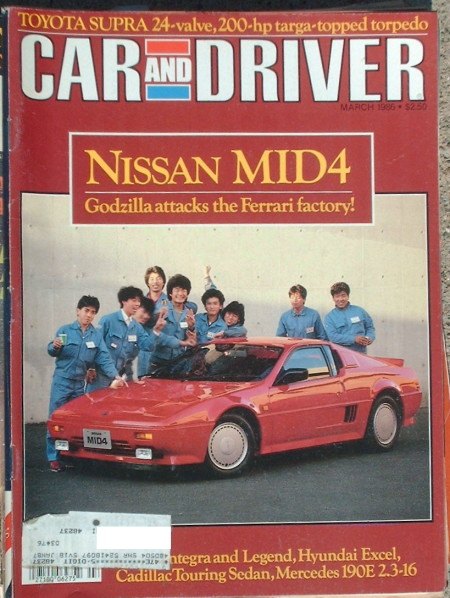Magazine Memories: The Big Buff Book Cover-Up, Part 2

We continue our look at the rock stars of car magazines, the concept cars splashed across the covers, cars that rarely if ever went anywhere.
The cover concept dream cars that I find most intriguing are the stillborn ideas, cars that were not quite vaporware, but that also never made it past prototype stage into production. Some were from specialist manufacturers, others from new startups and yet others from large and established firms. Some, like the six-wheeler Panther, were so unique that they have stuck in my memory for decades. Others completely slipped my mind. Most of them, I’m sure, sold more magazines than cars.
If I asked you to name a major Japanese automaker that developed a mid-engine sports car you’d most likely mention Toyota and the MR2 or Honda’s highly esteemed Acura NSX. You probably wouldn’t mention Nissan.
Prepared for the 1985 auto show season, and featured on the cover of the March ’86 Car and Driver with a feature article penned by Csaba Csere, the MID4 was the brainchild of Shinichiro Sakurai, father of the Skyline sport coupes. Pre-dating the NSX, the MID4 was the first “take no prisoners” sports car design from a major Japanese car company.
The MID4 show cars were not static displays, but rather they were fully engineered runners with the look of pre-production prototypes. The article and Nissan gave every indication that the MID4 was slated for production, with statements like, “six second generation [prototype] cars have been built, and these are said to be very close to what’s planned for the final production model,” and “production, which will likely be limited to 10,000 cars a year, should begin by early 1987 for the home market, with American deliveries scheduled to start later in the year.”
Though Sakurai said that development would be finished by the end of 1986, a third generation prototype, the MID4 II, was prepared for the 1987 Tokyo auto show, and the car remained in concept form. While many of the technologies featured on the MID4 eventually found their way to Nissan production cars, the MID4 itself remained a dream and Nissan has yet to build a mid-engine production car (let’s not quibble about “front mid engine” layouts of which I’m sure the GT-R is one – most decent handling cars with the engine up front put it behind the axle line – when I say mid-engine, you know what I mean, engine located between the passenger compartment and the rear axle).
Years before the Toyota LF-A, Acura NSX or even the Nissan MID4 were developed, another Japanese company attempted to challenge the Italian exoticars. Dome, a race car constructor and component vendor with roots in modifying and racing S600 Honda roadsters in the mid 1960s, announced its intention to produce the P-2, a tube framed two-seater, powered by a Nissan L-28E inline six as fitted to the 280ZX, planned to be turbocharged in the production car. The Dome P-2 was featured in Dennis Simanaitis’ cover story in the September 1979 Road & Track. Simanaitis admired the P-2’s fit and finish for a prototype, which he called “exceptional”, and the car’s styling, which he compared favorably to the Lamborghini Countach.
Using an amalgam of custom bits and parts sourced from major Japanese automakers, Dome appears to have crafted a credible performance car. Interestingly, the car was not intended for the Japanese domestic market (the TLA, JDM, btw, was not to be used for many years yet). At the time, two-seaters that were “too sporty” had a rough time receiving Type Certification from the Japanese government. An American subsidiary was set up to sell an initial run of 30 P-2s at a 1980 price of $60,000 ($154,000 in 2009 dollars).
According to Dome’s website, the plan to homologate the car for US requirements was serious but an opportunity came up for the company to race at LeMans in 1980 and the P-2 production plans fell by the wayside. The company still builds open wheel and sports car race cars, and has had some success in Formula 3. The company again flirted with building a production car, the Jiotto Caspita, but the late 1980s recession in Japan put paid to that idea.
One thing common to all cover concepts is distinctive styling. There’s a reason why magazine editors like to put dream cars on their covers – they generally are eye-catching designs, for the good or for the bad and they sell magazines. Some are attractive and some are hideous. Most seem to be cutting (sometimes bleeding) edge modern designs with mechanicals that use the latest technology – or so their PR folks say. Every few years, though, someone tries to market cars with modern mechanicals overlaid with styling evocative of 1930s vintage Auburns or Delahayes. In that class sits the Cumberford Martinique, pictured in all its mahogany glory on the cover of the April 1982 Car and Driver.
The Cumberford Martinique was the product of designer Robert Cumberford. Cumberford has had a long and interesting career that included stints at GM styling, Holman-Moody, Intermeccanica, writing for Car and Driver, and running his own industrial design firm. He still keeps his hand in automotive styling, contributing styling analyses to Automobile magazine. Cumberford had significant backing in the form of Henry Burkhardt III, founder of Data General, an early success story in the computer industry, plus the cooperation of BMW and Citroen, who provided the powerplant and running gear, as well as Renault, whose wind tunnel was used to refine the design.
Though it had a thoroughly modern chassis and drivetrain, and was fabricated from advanced alloys and composites, the Martinique was classically styled in the 1930s vein, with flowing pontoon fenders made of Kevlar, carbon fiber and structural foam veneered with African mahogany. The Martinique use Citroen hydropneumatic suspension units and steering, sourced from the CX (the CX’s front suspension was used at both ends of the car), and used the complete drivetrain, engine, transmission and rear end, from the 7 series BMW of the day. Custom half shafts connect the BMW hardware to the Citroen wheel hubs.
Rather than a hodgepodge, it appears that the Martinique was well engineered, and Cumberford claims the demonstration prototype has been a reliable driver over the years. The latest technologies and materials were used to fabricate and assemble the car, and their use was reflected in a 1982 price of $125,000. Adjusted for inflation that’s $274,000 in 2009 dollars. That may explain why they never built any beyond the initial prototypes, though an initial production run of 350 was anticipated.
To be continued …

Ronnie Schreiber edits Cars In Depth, the original 3D car site.
More by Ronnie Schreiber
Latest Car Reviews
Read moreLatest Product Reviews
Read moreRecent Comments
- VoGhost I suspect that the people criticizing FSD drive an "ecosport".
- 28-Cars-Later Lame.
- Daniel J Might be the cheapest way to get the max power train. Toyota either has a low power low budget hybrid or Uber expensive version. Nothing in-between.
- Daniel J Only thing outrageous was 400 dollars for plug replacement at 40k miles on both our Mazdas with the 2.5T. Oil change every 5K miles.
- EBFlex These are very cool. Pointless, but very cool. I miss the days of automakers building wacky, fun vehicles like this.





































Comments
Join the conversation
The MID4 looks like a 90% scale model of an Esprit X180.
Just a couple more things, the MID-4 II was powered by a VG30DETT. I always thought the MID-4 II looked too similar to the NSX for coincidence.....